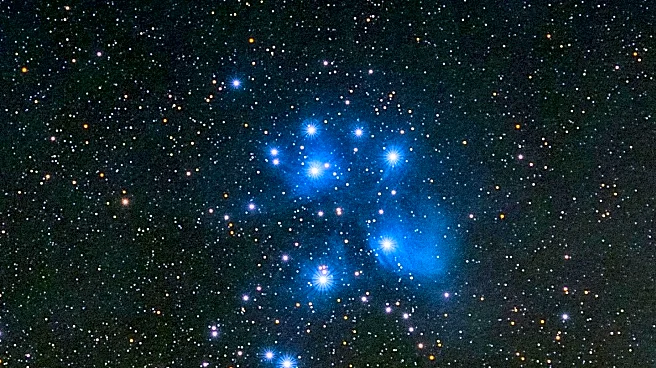What's Happening?
Astronomy enthusiasts are encouraged to observe the Great Square of Pegasus, a prominent asterism visible throughout the night despite the bright moonlight. The Great Square is composed of four stars: Gamma Pegasi, Markab (Alpha Peg), Scheat (Beta Peg), and Alpheratz (Andromeda's Alpha star). These stars form a large diamond shape in the sky, marking the body of Pegasus the Winged Horse. The observation is best performed an hour after sunset, with the square rising in the east and traversing the sky overnight. Despite the waxing gibbous moon, the article suggests learning the Great Square as a reference point for finding fainter celestial objects under darker skies.
Why It's Important?
The visibility of the Great Square of Pegasus offers a unique opportunity for amateur astronomers and stargazers to familiarize themselves with a key celestial marker. This asterism serves as a guide to locating fainter objects in the night sky, enhancing the stargazing experience. Observing such formations can deepen understanding of celestial navigation and contribute to educational and recreational activities related to astronomy. The event underscores the importance of celestial observation in fostering interest in science and technology, potentially inspiring future astronomers and scientists.
What's Next?
As the moonlight diminishes in the coming nights, observers will have better conditions to explore fainter celestial objects using the Great Square as a reference. Astronomy clubs and enthusiasts may organize viewing events to capitalize on clearer skies. Additionally, educational institutions might incorporate this observation into their curriculum, encouraging students to engage with astronomy through practical experience. The continued interest in celestial events could lead to increased participation in astronomy-related activities and discussions.
Beyond the Headlines
The observation of the Great Square of Pegasus highlights the cultural and historical significance of astronomy. Such events can foster community engagement and promote awareness of the night sky's beauty and complexity. The practice of stargazing can also encourage environmental consciousness, as it requires dark skies free from light pollution. This aligns with broader efforts to preserve natural environments and promote sustainable practices.











